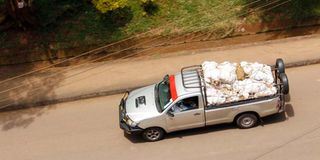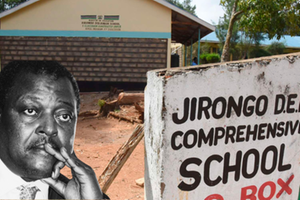
A vehicle ferrying miraa from Meru to Nairobi.
| File | Nation Media GroupNews
Premium
A day on the ‘fast lane’ with miraa drivers
What you need to know:
- One vehicle carries miraa worth about Sh2.5 million, while a lorry carries produce worth Sh5 million.
- Optimally, up to 60 vehicles move the miraa on any given day, translating to about Sh150 million daily.
- Cumulatively, the miraa industry is worth up to Sh40 billion annually.
It takes a lot of guts to play a game of chicken on a busy Kenyan highway but one needs to have audacity by the barrel-load to do it to the Inspector General of Police.
Former Inspector General of Police Joseph Boinnet witnessed firsthand this complete disregard of road safety when he was in office.
The police boss was headed to Meru for Madaraka Day celebrations in 2018 when his official motorcade was forced off the road by the speeding miraa vehicles.
Now that is audacity.

The daredevils behind the wheels of the pick-up trucks and station wagons plying the Meru-Embu-Nairobi and Nanyuki-Nairobi highways live their lives on the fast lane -- literally.
However, courting death by constantly speeding towards oncoming traffic is just part of a day in the “office” for those in the miraa (khat) business.
The daredevils behind the wheels of the pick-up trucks and station wagons plying the Meru-Embu-Nairobi and Nanyuki-Nairobi highways live their lives on the fast lane -- literally.
They are considered some of the most notorious and reckless drivers on Kenyan roads. To this group of road users, getting the drug to the market on time is more important than traffic laws.
Why the rush?
But the question on most people’s minds is always; why the rush?
The answer is simply money -- millions of shillings to be specific.
One vehicle carries miraa worth about Sh2.5 million, while a lorry carries produce worth Sh5 million. Optimally, up to 60 vehicles move the miraa on any given day, translating to about Sh150 million daily.
Cumulatively, the miraa industry is worth up to Sh40 billion annually.

One vehicle carries miraa worth about Sh2.5 million, while a lorry carries produce worth Sh5 million.
Miraa is a highly perishable commodity and must reach consumers as fresh as possible. The stimulant, primarily produced in Meru, begins to lose its potency immediately it is harvested and since it is transported as far as Somalia, time and speed are critical in this business.
With millions of shillings on the line daily, nothing else matters, not the safety of the crew onboard and definitely not any other road user.
Mr Samuel Mwika, the Meru Miraa Drivers Association chairman, prefers to view himself and his colleagues as Kenya’s “most skilled drivers”. Mr Mwika drove the miraa vehicles for 33 years before retiring last year, and for him, the aim is to deliver a highly perishable product on time.

A vehicle ferrying miraa passes a police checkpoint.
Mr Mwika has cheated death as a miraa transporter.
He was involved in an accident as he tutored one of his recruit drivers. It was on January 2, 2012 when he travelled with his student, who joined us for the Nairobi trip, this time as a passenger.
At the time of the accident, Mr Mwika did not know that the young man had broken one of the rules -- which was a driver must sleep for at least five hours before embarking on a trip.
“He had spent New Year’s night partying. On the day of the trip he insisted that I buckle up my seat belt but for some reason I ignored,” Mr Mwika said.
Upon reaching a known blackspot, about 10 kilometres from Meru town, disaster struck. The driver lost control of the vehicle and hit a road barrier as he negotiated a corner.
Mr Mwika was thrown out of the open window and landed on a slope several metres from the road. The vehicle rolled after him, coming to a stop a couple of metres from where he lay, writhing in pain.
While the driver escaped unscathed, Mr Mwika’s legs were so badly injured that he was hospitalised for several months.
“But this is a normal risk in this business”, he said, calmly.

A vehicle ferrying miraa in Meru town on February 15, 2021.
The Nation decided to have a firsthand experience of what it is like inside the miraa carriers.
Loading of the miraa begins at 6am at Kangeta town, about 40 kilometres north of Meru town.
Two vehicle models are most preferred for the business of transporting -- Toyota Hilux single cabin, built for transporting loads, is preferred for carrying premium khat over long distances; while the Toyota Probox is used to carry muguka (a lower quality variant of the stimulant comprising mostly of leaves grown in Embu County). The Probox is loved for its versatility and low fuel consumption, making it economical over short distances and remote destinations.

A vehicle ferrying miraa to Nairobi.
The driver behind the wheel for our trip used the pickup, setting the departure at 10am.
Before the start of the journey, he recommends a kilo of miraa to chew on the way, saying it was going to be an experience of a lifetime and the high would be worthwhile.
The first shock is the realisation that the vehicle has no safety belt.
"Hapo hakuna belt. Lakini usiwe na wasiwasi, utafika (There is no seat belt, but do not worry. You will arrive safely),” he says.
Now, that is not something anyone wants to hear before embarking on probably the riskiest ride of their life, in the hands of someone who considers death an occupational hazard.
After loading and securing the sacks with ropes, which takes about 20 minutes, the driver zooms off, hitting zero to 100 kilometres per hour in seconds. Two more vehicles join the journey and make a small convoy.
We are in Meru town at exactly midday and the heavy traffic, especially at Makutano junction appears to make the driver impatient as he hoots incessantly, with most of the motorists giving way.
He acknowledges cheers from “fans” who call out his name.
The journey between Meru and Chuka is rather smooth but tense, with the convoy zooming along the hilly road.
The vehicle, however, has a slow puncture on the right back tyre and despite the high speed, the driver keeps sticking his head out of the open window to check its condition, rather than use the side mirror or pull over.
At Chuka, he decides to stop at a petrol station and fill up the pressure in the tyres.
In the process, the other two vehicles zoom past him.
Interestingly, the vehicles must move in a convoy, and now the driver has to catch up with vehicles doing speeds of up to 140kph.
At that point, the true madness of a miraa driver is revealed.
He swerves into the road and in seconds, the vehicle is moving at 120kph; then 140kph. He maintains this speed for about 20 minutes.
Being a first time passenger inside one of these vehicles, it is only natural to find yourself clutching onto your luggage, whispering the same prayer over and over.
When the speedometer on a vehicle whose top speed is 200kph, reads 160kph, and is still increasing, you start questioning some of your life choices.
At such speeds, he will overtake every vehicle along the way and in case there’s any oncoming traffic, the motorists will have to give way. Every round of overtaking is a close call, especially because just like in a game of chicken, the driver only bets on the fear of other road users for our safety.
In Embu, the driver slows down due to heavy traffic and on inspecting the tyre, he decides to change it. Ideally, these vehicles have two spare tyres strapped to the back to allow a fast change when the need arises.
Over the next 10 minutes, the driver looks unsettled as he still needs to catch up with the rest of the convoy.
On a normal drive, the rice fields on the Embu-Mwea road are a sight to behold. Today, however, the scenery flashes by in a green haze punctuated with dots for open fields as the vehicle cruises at high speed. Motorists give way and bodabodas are shoved off the road.
All through, the windows are lowered -- the gusts of wind hitting us like blows. The drivers prefer this, saying it keeps them alert,
“We got them!” the driver shouts as we enter Sagana and he joins the convoy.
Now in a convoy, the three vehicles take turns overtaking slow vehicles, switching from one lane to the other. They maintain a speed of 150kph as we approach Thika Road.
Inclusive of the two stops, the entire journey takes exactly three hours, where it usually takes at least five hours in a public service vehicle.
Interestingly, on the entire 269-kilometre stretch, the vehicle was not flagged down by a single police officer.






